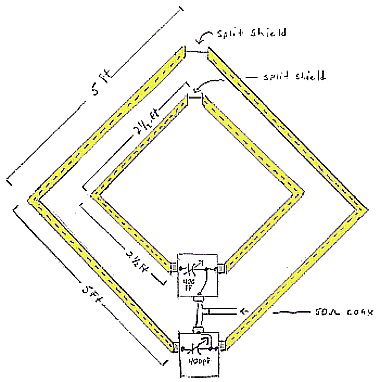|
80/160
m coax receiving loops
By Spencer F. Ritchie, 1999
http://www.qsl.net/kc2tx/loopschematic.htm
Several years ago a friend of mine (W7AE) and myself became
interested in low band DXing.
Lacking room for a beverage receiving antenna, we constructed
several loop receiving antenna to see if we could find a suitable
low /lower noise receiving antenna.
W7AE built the first loop for 160m following plans laid out in
the ARRL Antenna Handbook. Encouraged by the results I built one
for 80m.
I found that with a proper pre-amp, such the Palomar series,
or Ameco's PT-3 there was a significant lowering of noise, but
the signals that I was unable to hear on my sloper now were quite
workable using the receiving loop.
For the past several years, we experimented with several different
configurations, including a circular, and square loop. We found
that the diamond configuration worked the best.
The 80m version requires a pre-amp to bring the signal up to an
acceptable quality.
We've found that there is a one to two S unit differrence (depending
how high you set the gain on the preamp)in the lowering of noise.
There have been several times that the loop has made the
differrence between working a DX station or not hearing him on
my sloper.
Though the antenna is not a beverage, we've found it to be a good
alternative.

For the
160m loop
To construct the 160m loop you'll need 20ft on RG-59.
Fold the RG-59 in half. On the 160m loop, it would be about 10ft
from the end. On the 80m loop, it would be about 5 ft. from the
end.
You then mark the center, then measure 1/2 an inch on both sides.
Strip away the outer cable, the braid, and then the foil covering
the center conductor insulation.
I then usually use heat strink to weatherproof what I've cut away.
Then cut some schedule 40 2 inch pvc pipe into 3 lengths. Each
should be 45 inches long. Cut one to 56 inches. That one will
be the mast.
Assemble the lengths you cut into a "T" configuration. Measure
from the center 43 1/4 inches on the three 45inch lengths. Drill
a hole large enough to pass through the RG-59.
For the 80m loop
Drill three holes 20 1/2 inches measured from the center of the
"T".
Loop the 20ft RG-59 through the holes drilled at 43 1/4 inches,
then loop the 10ft length through the holes drilled at 20 1/2
inches.
Install the male type "f" and weather boots on the RG-59 you just
looped through the "T".
Attach the 20ft cable to the 160m matching box. Also do the same
with the 80m box.
I find it easier to aim the 160m box with the SO-239 down. And
the 80m box with the SO-239 up. That way the it will keep the
harness short.
Drill the mounting holes through the box, once you pull the loop
tight.
To tune the loops attach each loop separately to your transceiver.
Do not apply RF to the loop. This will damage the components,
and probably your transceiver.
Place the dial of your transceiver to the part of the band you
want to use the loop on. Then adjust the the trimmer capacitor
for maximum noise. Do this for both loops.
Then attach the harness. The loops should be ready for use. I
usually weatherproof the boxes and frame. And I add a wood dowling
to strengthen the mast.
Construction of the boxes
 The
trimmer values are approx. the values shown in the drawing right. The
trimmer values are approx. the values shown in the drawing right.
However I've used ARCO 468 for the 160m loop and ARCO 467 trimmers
for the 80m loop, with great success.
RG8X can be of random legth. I usually cut them to fit between
the boxes.
The lead to the receiver can be of any length.
|





